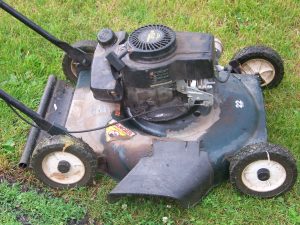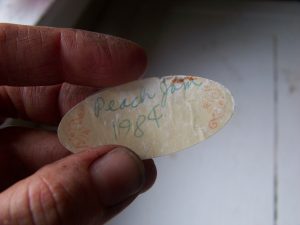Or, two ways of looking at a lawn. (With another glass of wine I might be able to manage the standard thirteen….)
Mower A:
 Mower B:
Mower B:
 Mower A: used, gas-powered Craftsman gifted to me by my brother-in-law, then traveled by circuitous routes involving broken promises of mower transit in an SUV by male family members (“yes, I DID leave it at home! I’m not gonna ride 500 miles smellin gasoline!”), victorious self-assertion by my mom (“I’m gonna get that mower to you ANYWAY!”) and one staggering UPS man (“damn, what is IN this box???”) to northeast Iowa. This summer, after three hard years of use on top of an already long life, the gas tank (and the wheels) are falling off for good and may no longer be amenable to my own brand of redneck engineering or to further life support by our Very Talented Local Small Engine Repair Man. A couple weeks ago I pulled the starter cord and the whole engine block came loose from the deck. I can see the top of the blades from above. The screw holes are totally stripped out. I think it might be time to see if I can work a trade with the VTLSERM for this recyclable-reusable engine and frame in exchange for future repairs on my little tiller and blade-sharpening on…
Mower A: used, gas-powered Craftsman gifted to me by my brother-in-law, then traveled by circuitous routes involving broken promises of mower transit in an SUV by male family members (“yes, I DID leave it at home! I’m not gonna ride 500 miles smellin gasoline!”), victorious self-assertion by my mom (“I’m gonna get that mower to you ANYWAY!”) and one staggering UPS man (“damn, what is IN this box???”) to northeast Iowa. This summer, after three hard years of use on top of an already long life, the gas tank (and the wheels) are falling off for good and may no longer be amenable to my own brand of redneck engineering or to further life support by our Very Talented Local Small Engine Repair Man. A couple weeks ago I pulled the starter cord and the whole engine block came loose from the deck. I can see the top of the blades from above. The screw holes are totally stripped out. I think it might be time to see if I can work a trade with the VTLSERM for this recyclable-reusable engine and frame in exchange for future repairs on my little tiller and blade-sharpening on…
Mower B: Scott 20″ totally-human-powered, barely-used reel mower just purchased for less than half the cost of a new one at a friend’s garage sale. After months of planning and comparison-shopping, in line with the backyard-homesteading-sustainability moves y’all already know about, a mower fell in my lap. Always a useful corrective to consumer itch: Bide your time, save your money, and you will be able to take advantage of the real find when it arrives, or it’ll find you. (And now that debtlessness draws nigh, I hope to be able to support some wonderful local artists more often in the future — like Elisabeth Maurland and Bonnie Koloc and Nate and Hallie Evans — for these very reasons. It’s not a bad consumer-decision-making device: is this an object of mass-produced crap designed to feed you deeper into the corporate woodchipper, or is it a beautiful object, including a vegetable or a loaf of bread, made by someone you know in the place you live?)
Anyway. Each mower came into my life from a friend or family member. Each (A in particular) has given me good service. But only B gave me a gift — within the first half-hour of my using it.
Yesterday afternoon, before cutting my lawn with my “new” reel mower, I made the apricot-and-vanilla-bean preserves from CANNING FOR A NEW GENERATION this afternoon – even easier than before, especially with my ancestral canning pots, rescued from the basement (see last post.) Apparently there was more canning in my mama’s house than I remembered, and I was a part of it. Because in the grass where I had washed out the pots on the lawn was a little oval piece of paper:
 Peach Jam, 1984. This is my handwriting, age ten.
Peach Jam, 1984. This is my handwriting, age ten.
How these little emissaries of former selves arrive, out of nowhere. The reel mower rolled up to it, quietly. The gas mower would have chopped it up or blown it away. And the pictures are seeping back into my memory now: steaming bowls of peaches poached till the skins slip off, gleaming heaps of pits on the counter, the most wonderful simmery sweet peach fragrance in the world.
“When from the distant past nothing remains, after the beings have died, after the things are destroyed and scattered, still, alone, more fragile, yet more vital, more insubstantial, more persistent, more faithful, the smell and taste of things remain poised a long time, like souls, ready to remind us, waiting and hoping for their moment, amid the ruins of everything else; and bear unfaltering, in the tiny and almost impalpable drop of their essence, the immense architecture of memory.” –Marcel Proust, Du côté de chez Swann (1913) in: À la recherche du temps perdu vol. 1, p. 47 (Pléiade ed. 1954)(S.H. transl.)
In my freshly cut yard last evening I started reading YOU ARE NOT A GADGET by Jaron Lanier, which speaks of humanity, individuality, genuine connectedness and community, and the ways current forms of computing and social networking have the potential to wreck them all. It’s great. I’m learning a ton about computer engineering and models of the mind that will help me with my own project. And I’m pondering “the Singularity” Lanier mentions — the dream of more than a few computer scientists that through the Internet and computers the world can become one single interconnected consciousness, sleek and oddly placeless, omnipresent, everywhere and nowhere. How ironic that to non-engineers, “singular” means unique. Irreplaceable. Individual.
Even Lanier, a pioneering computer scientist, fears the Singularity, and rightly so. Unity, conformity, lack of multifariousness and texture and variety are inherently totalitarian, as is the fantasy of limitless expansion and the technology which promises to make all things possible by superseding human limits, which may, at many levels, mean superseding humanity itself. (See Hannah Arendt on the Nazis’ “all is possible” ideology.) Shaving down, smoothing off, blending into the hive mind can become very ominous things. Yes, I know there’s more than a little irony I’m saying this on a blog. But blogs, done rightly, may be part of the solution. (You’ll just have to read the book.) I don’t think it’s an accident that the symbol of the new “iCloud” is a totally unitary shape, a closed system with borders that are hard and closed despite their cheery, graphic-tweaked roundness. It tries to be soft, organic, trustworthy-looking. It tries really hard.
 We vote against the Singularity by what we do and use and value. Last week I suggested to our college’s authorities that in this time of cost-cutting and renewed commitment to sustainability, we stop our annual ripping up and resodding of sidewalk borders where ice-salt makes them brown; that we find some alternative to the salt; and most of all that we quit spraying herbicides on our college lawns, instead putting up little educational signs to explain why one might see the occasional dandelion. I was told that for visitors to campus, “first impressions are important” and so they are leery of looking unkempt, signs notwithstanding. I understand that. But this is a low-hanging fruit for some local activism, I hope. I sat with my students — those flowers in our best garden — on that lawn just the other day. They need us to do better, and teach them better too.
We vote against the Singularity by what we do and use and value. Last week I suggested to our college’s authorities that in this time of cost-cutting and renewed commitment to sustainability, we stop our annual ripping up and resodding of sidewalk borders where ice-salt makes them brown; that we find some alternative to the salt; and most of all that we quit spraying herbicides on our college lawns, instead putting up little educational signs to explain why one might see the occasional dandelion. I was told that for visitors to campus, “first impressions are important” and so they are leery of looking unkempt, signs notwithstanding. I understand that. But this is a low-hanging fruit for some local activism, I hope. I sat with my students — those flowers in our best garden — on that lawn just the other day. They need us to do better, and teach them better too.
The reel mower doesn’t cut the grass as low as the gas-powered one did, even on its lowest setting. But I can hear everything going on around me while I walk and push: the subtle rattle and scissorly click of the blades through the grass, the birds and all the little scuttlings of any summertime yard. When I am done, the grass looks neatened but not shaved, lush but not too long. The lawn looks like a restful place, a pleasing one, not too worried about being Brought Under Control, mowed and sprayed into golf-course submission. It looks happy. It looks alive.
And in the evening light, looking out over my garden – its explosion of herbs and lilies and perennials just coming on, the little white constellations of clover low in the grass that the reel mower spared, the voices of my neighbors floating toward me, a friend approaching my gate, the little paper label come to me across a distance of twenty-six years from helping my mama put up peaches in the same pots I now use – I pondered what connections create and sustain life and community in all their infinitely glorious variety, and what only offer illusions, and how we can continue to tell the difference. And why we have to.

Perfect! Love the “subtle rattle and scissorly click of blades.” Your’s sounds like a wonderful yard. Thanks also, for continuing the discussions and peaceful disturbances around campus; glad to see the beat goes on. 🙂 –erin f.
Beautifully done–I kept rereading the last paragraph just for the sheer pleasure of your fine writing. You also make me feel much better about the way my lawn looks now under the gentle power of our reel mower (a bit shaggy, but not beaten into submission!). I was reading in _Radical Homemakers_ last night that using a power mower for only 30 minutes emits exhaust equivalent to a car driving for 187 miles. So you really are making the world a better place, one reel-mowed lawn at a time!